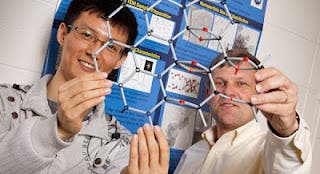Graphene has been countless times hailed as the material at the forefront of the coming technological leaps ahead in the future, thanks to its extraordinary properties and countless applications. Electronics is where graphene shines the most, though, and now scientists at University of Wisconsin-Milwaukee have managed to synthesize a semiconductor variant of graphene which might lead to a whole new generation of faster and more reliable electronics.

What makes graphene so remarkable is that the one-atom thick layer of carbon has a much better conductivity than copper wires and even gold. Silicon, the material used in 99.99% of today’s working transistors, has nearly reached the limit at which it can be shrinked without drastically loosing its electrical properties. Naturally, the next step for technology is using materials from the graphene family.
The main building block of the future’s electronics might be a variant called “graphene monoxide (GMO),” which is easier to scale up than graphene, and also exhibits semiconducting properties. Until recently, graphene only presented insulating and conducting properties.
“Now all three characteristics of electrical conductivity – conducting, insulating and semiconducting – are found in the carbon family, offering needed compatibility for use in future electronics,” says the team.
Like all great discoveries, the researchers discovered GMO by accident. The team was studying a hybrid nanomaterial comprising carbon nanotubes with attached tin-oxide nanoparticles for use as a sensor.
The team discovered GMO while researching the behavior of a hybrid nanomaterial comprising carbon nanotubes with attached tin-oxide nanoparticles that was being investigated for use as a sensor. During one experiment when scientists attempted to synthesize graphene from graphene oxide (GO), a multilayer insulator, the researchers found that layers of GO became aligned and formed GMO.
The next step is more science. The team will need to find out what triggered the reorganization of the material, and also what conditions would ruin the GMO’s formation.
“In the reduction process, you expect to lose oxygen,” says Michael Weinert, professor of physics and director of UWM’s Laboratory for Surface Studies. “But we actually gained more oxygen content. So we’re at a point where we’re still learning more about it.”


